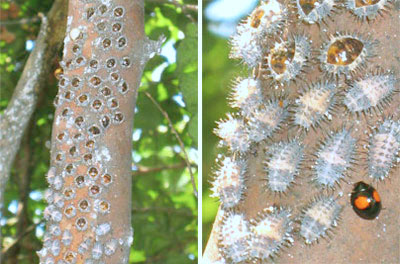Question of the Week: May 12, 2016
“What is this pest on my crape myrtle, and what can I do to stop it? Will it kill the tree?”

This was a serious invasion of crape myrtle scale from several years ago.
This is crape myrtle scale. It was first observed when a customer brought a sample into a nursery along George Bush Tollway in Plano in 2004.
Initially it was more of a novelty – an insect we had not seen before. In fact, entomologists in Texas, Florida and elsewhere initially struggled to determine the exact species.
Eventually it was determined that it is a scale insect native to China. Working with Dr. Mike Merchant, Extension entomologist with Texas A&M in Dallas, we have kept this information on the website of our Crape Myrtle Trails of McKinney. http://crapemyrtletrails.org/pest-control/ Scroll about halfway down on this page.
Two years ago, Dr. Merchant published this additional information via TAMU. http://citybugs.tamu.edu/2014/08/14/crape-myrtle-bark-scale-reduces-bloom/
This pest has now spread across the southern United States. Dr. Merchant’s reports give details of treatment options, and he has stated that mid-May is probably the best time.

Ladybird beetles are predators of this scale insect. If you see them, and if they seem to be making headway, give them a chance to do their job before applying insecticide.
2007 was the worst year for this pest that we have seen to date. Many plants were impacted, and the honeydew excreted by the scale insects evolved into trunks and leaves coated in black sooty mold. Gardeners were concerned about the black mold, when in reality it was the honeydew of the scale that gave sooty mold a perfect substrate on which to develop. As many asked, “How can I get rid of this black mold?”, they were focusing on the wrong part of the problem.
I am getting questions from many people on Facebook, in my newspaper columns and on radio, so I thought it would be appropriate to address it here.
In summary, two things worthy of note:
• The scale will not kill your crape myrtle, and
• You can help your crape myrtle significantly by applying a systemic insecticide to its root zone in May.
